yay
1/25
There's no tags or description
Looks like no tags are added yet.
Name | Mastery | Learn | Test | Matching | Spaced |
|---|
No study sessions yet.
26 Terms
Chauvet Cave Paintings pre-his
Location: Southern France
Medium: Cave painting
Significance: Discovered in 1994, these are among the oldest known cave paintings
Unique Feature: Unlike most Paleolithic cave art, these depict predatory animals (lions, rhinoceroses)
Preservation: Closed to public to prevent deterioration; replicas are displayed
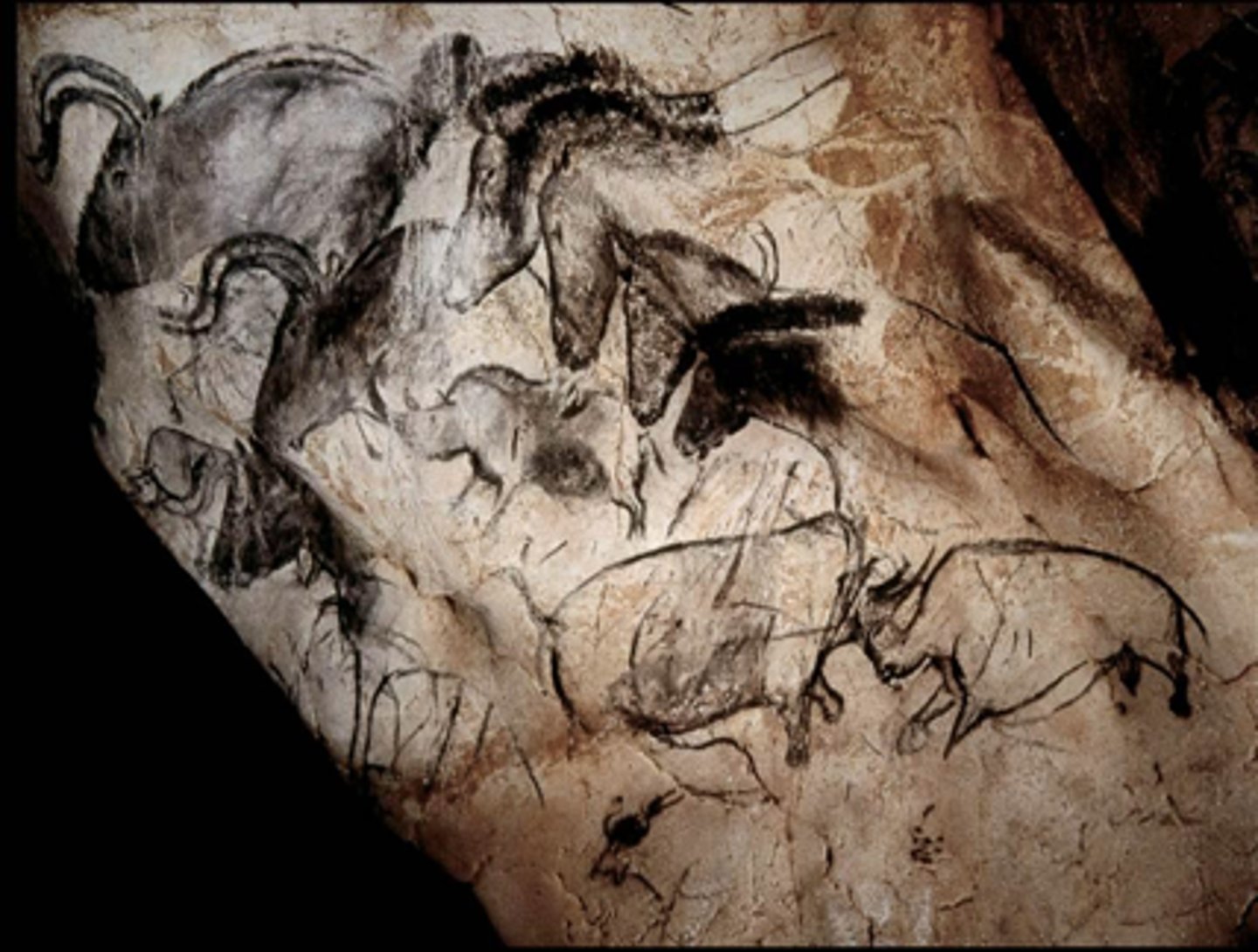
Venus of Willendorf pre-his
Location: Willendorf, Austria (now in Vienna museum)
Medium: Small sculpture
Features: Exaggerated large stomach and breasts, no facial features, braided pattern on head
Interpretation: Assumed to be a fertility figure, named after Roman goddess Venus
Mystery: True significance unknown due to age
Study Tip: Focus on the exaggerated feminine features and fertility symbolism
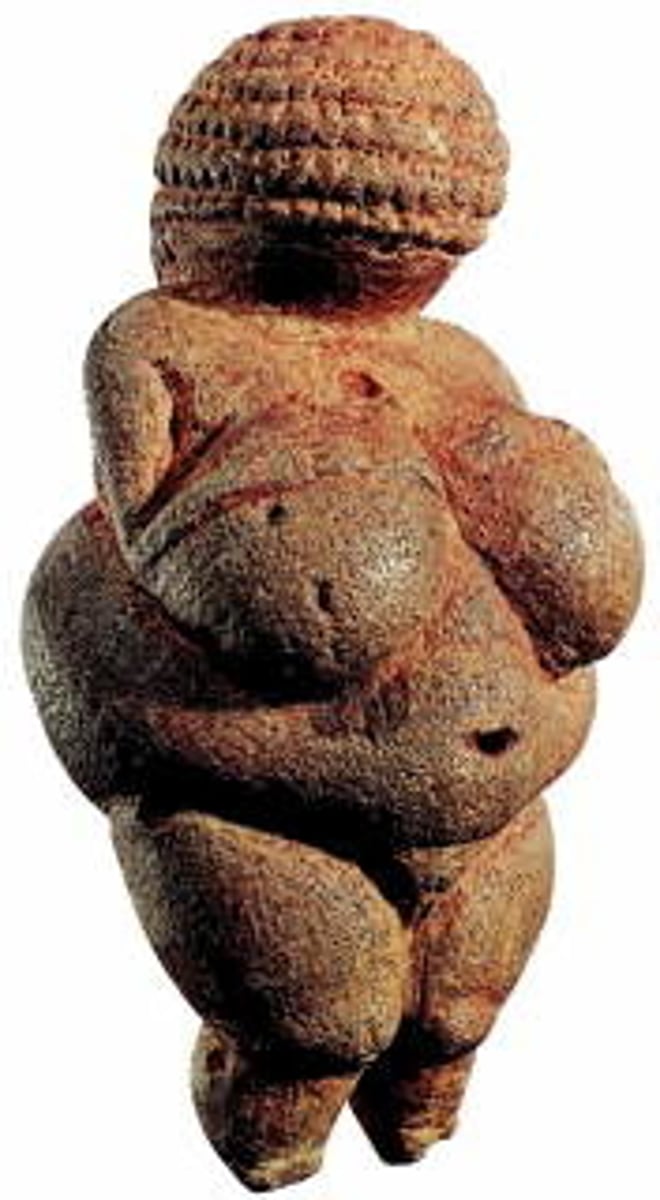
stonehenge pre-his
Location: Wiltshire, England
Medium: Architecture (stone construction)
Structure: Tall rectangular stones in circle, some with horizontal stones on top
Function: Burial site since beginning, aligned with summer and winter solstices
Mystery: Exact purpose unknown
Study Tip: Remember the astronomical alignment - this shows sophisticated understanding of celestial movements
Stonehenge was made using post and lintel construction
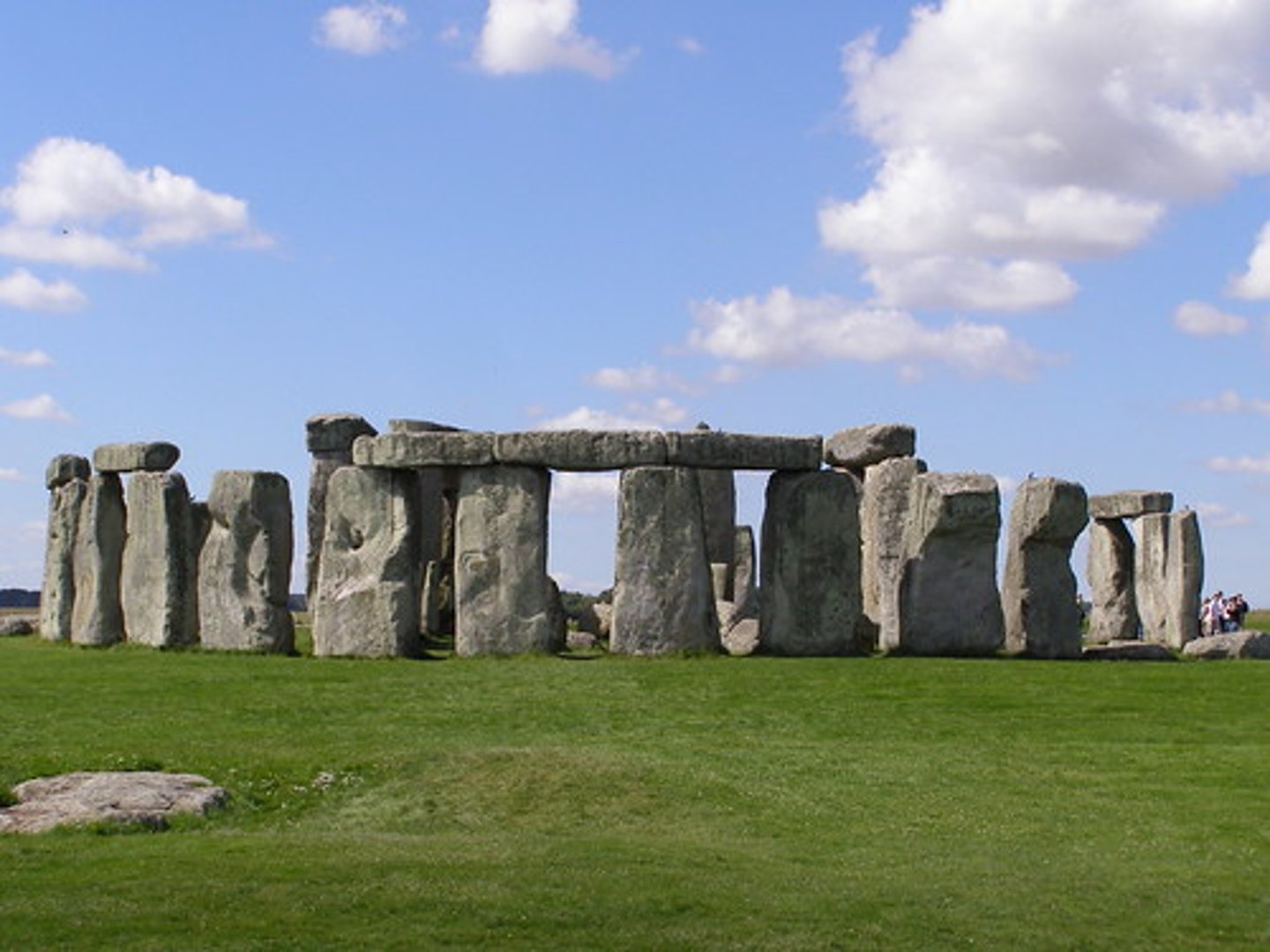
Akhenaten & Family Blessed by Aten ANC EGYPT
Period: New Kingdom
Location: Tel-el-Amarna, Egypt (now in Berlin)
Medium: Relief sculpture
Figures: Pharaoh Amenhotep IV (Akhenaten), Queen Nefertiti, their daughters
Revolutionary Style: Amarna style - elongated arms, sagging rounded bellies (radical departure from traditional rigid, idealized royal art)
Religious Significance: Shows worship of Aten (sun god)
Akhenaten and Family was important because they represent Akhenaten's religious revolution, establishing him and his family as the sole intermediaries between humanity and the god Aten.
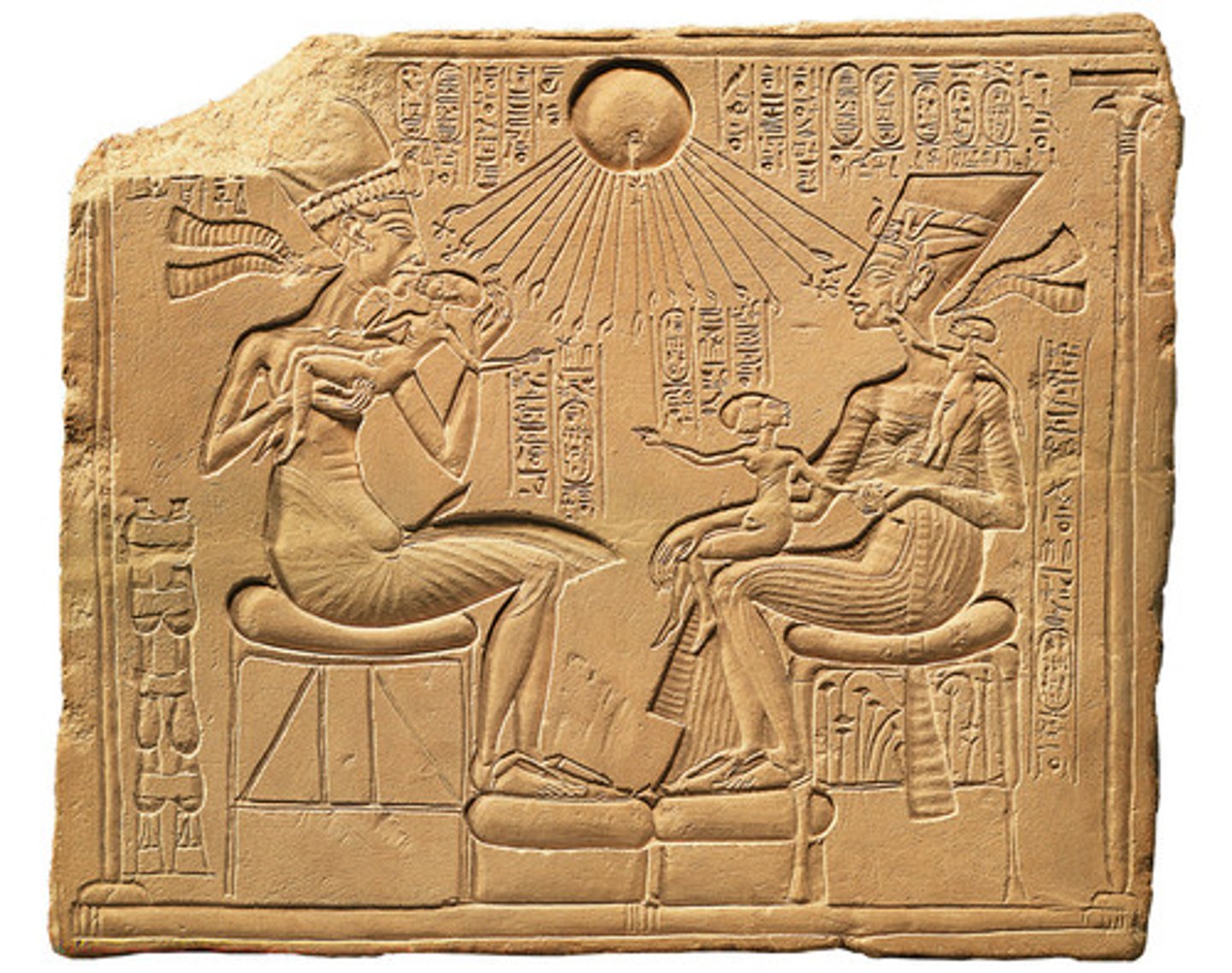
gold mask of tutankhamun anc egypt
Period: New Kingdom
Location: Valley of Kings, Luxor (now in Cairo)
Medium: Gold, colored glass, gemstones
Discovery: Found by Howard Carter in 1923
Cultural Impact: Made Tutankhamun the most famous pharaoh despite being historically unimportant
Legacy: Sparked global revival of interest in ancient Egypt, initiated era of "blockbuster" museum exhibits
The gold mask of Tutankhamun served as a protective funerary object designed to ensure the pharaoh's resurrection and eternal life.
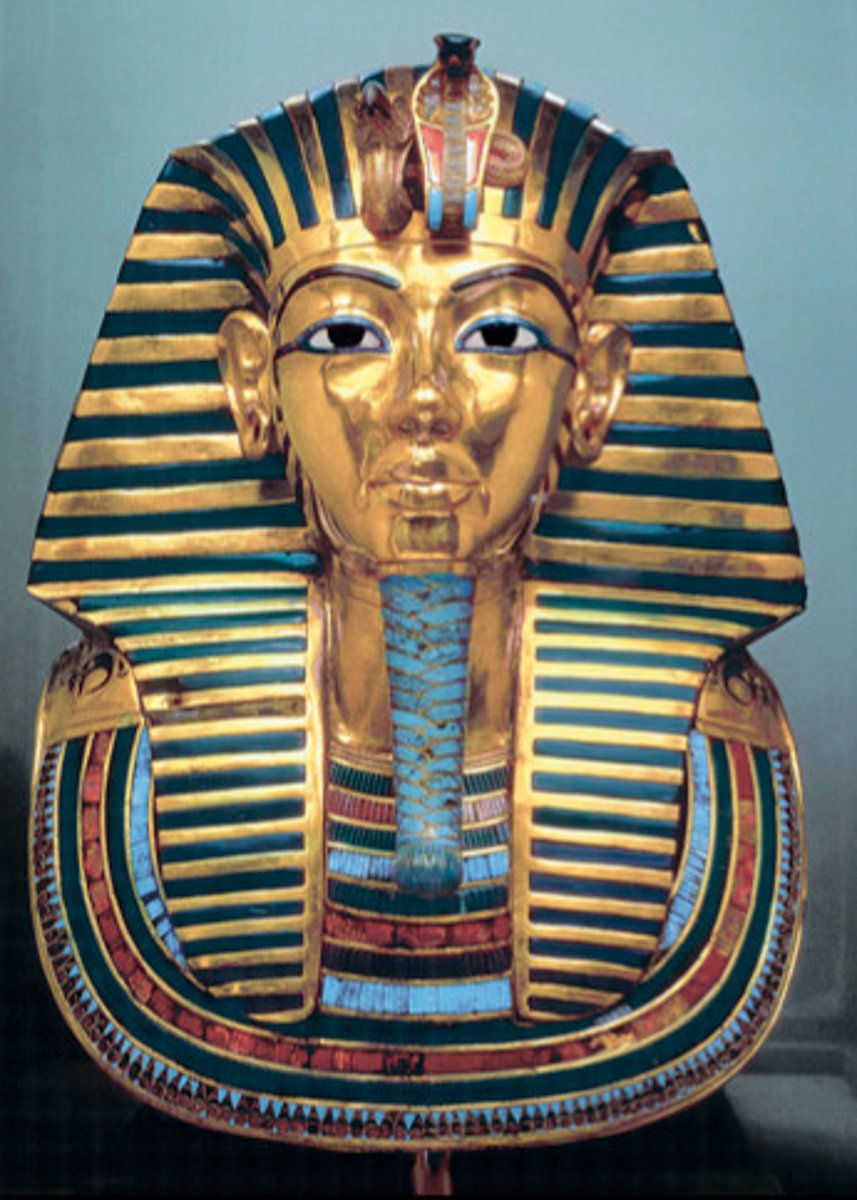
rosetta stone anc egpyt
Period: Ptolemaic Egyptian
Medium: Granodiorite stela
Languages: Three scripts - 14 lines Hieroglyphs, 32 lines Demotic, 54 lines Greek
Content: Celebrates reign of Ptolemy V
Discovery: Found by Napoleon's troops in 1799
Importance: Key to deciphering Egyptian hieroglyphics
Current Location: British Museum, London
Rosetta Stone helped to translate Egyptian Hieroglyphics
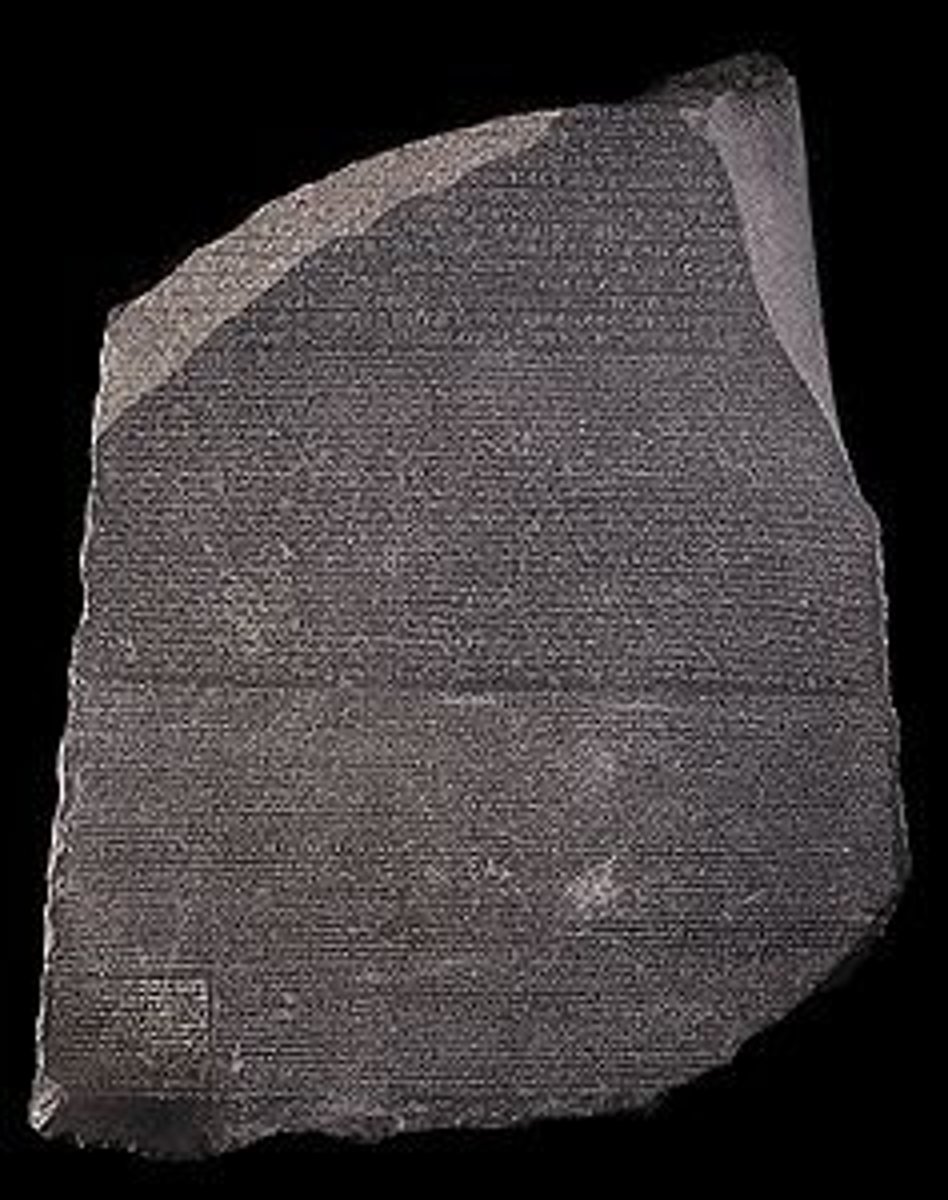
narmer palette anc egypt
Period: Early Dynastic Period
Medium: Carved stone palette (enlarged version of cosmetics mixing palette)
Significance: Shows some of the earliest known hieroglyphs
Imagery: King Narmer in different crowns, defeating enemies, arranged in registers
Artistic Conventions: Shows Egyptian artistic conventions (profile heads, frontal torsos)
Narmer Palette commemorates the unification of Egypt.
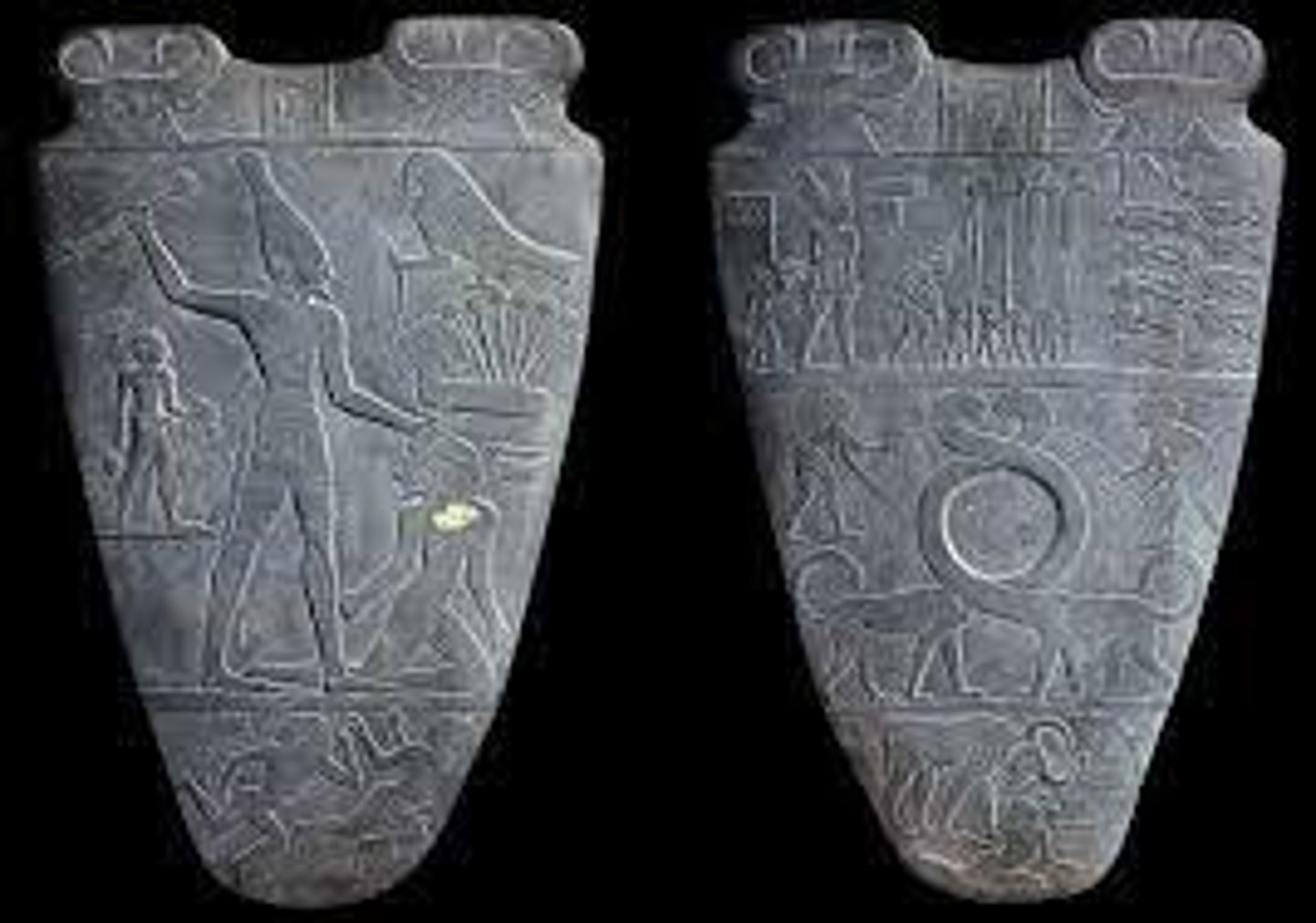
great pyramids of giza anc egpyt
Period: Old Kingdom
Rulers: Built for Khufu, Khafre, and Menkaure (4th Dynasty kings)
Structure: Square bases, four sloping triangular sides, pointed peaks
Construction: Cut stone blocks (original polished casing stones mostly stripped off)
Significance: Architectural wonders demonstrating ancient engineering ingenuity
Pyramids of Giza were used as tombs for pharaohs to ensure their passage into the afterlife and reflect their divine power.
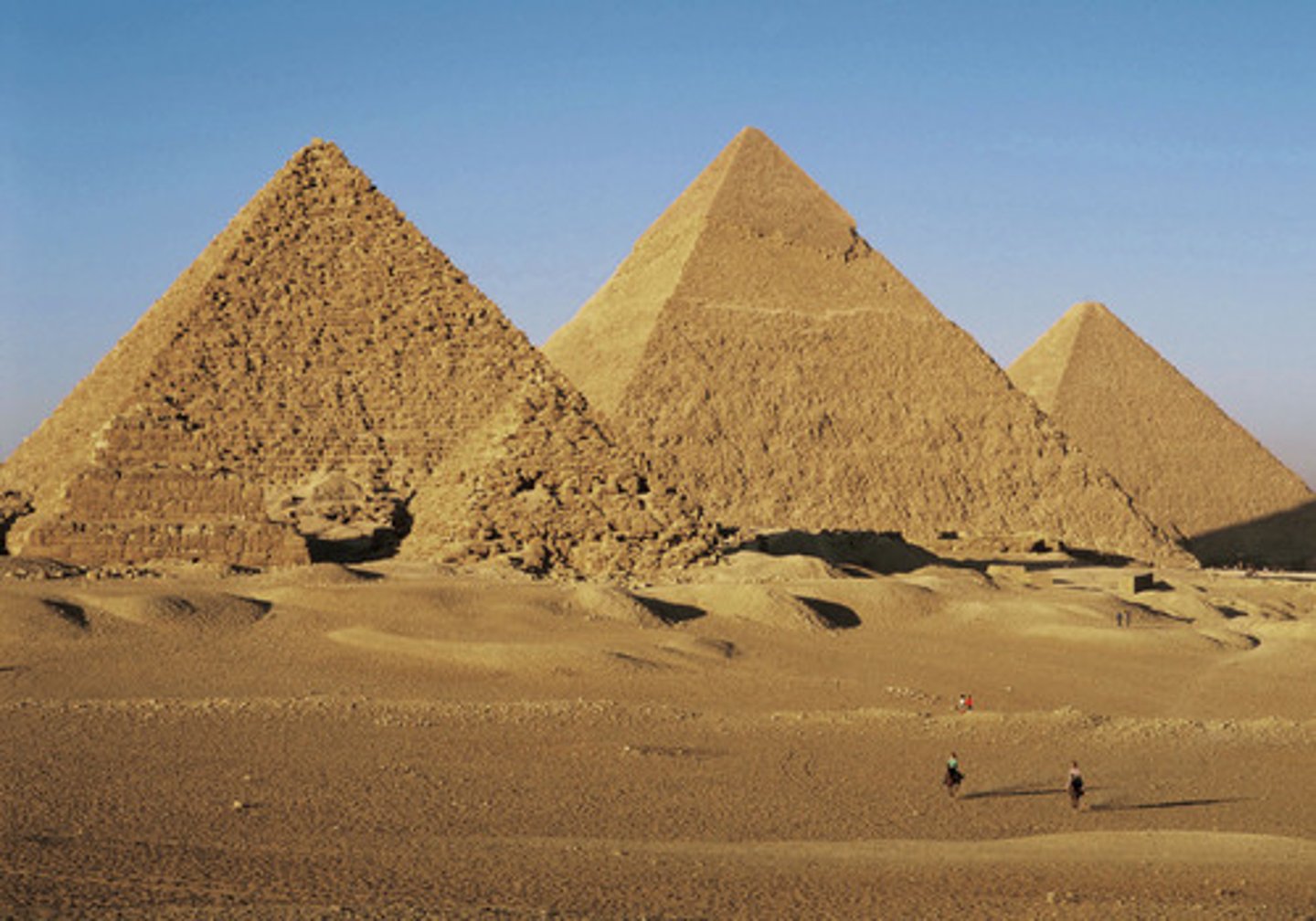
Large Kneeling Statue of Hatshepsut
Period: New Kingdom
Subject: Queen-turned-pharaoh Hatshepsut
Medium: Life-sized carved granite
Features: Kneeling figure with spherical pots, wearing kilt and false beard
Context: One of dozen identical statues lining processional route to Mortuary Temple at Deir el-Bahri
Historical Significance: Represents powerful female ruler who became co-ruler of reunified Egypt
The kneeling statue of Hatshepsut was important because it legitimized her rule as a female pharaoh by depicting her with traditional male iconography (the false beard and nemes headdress)
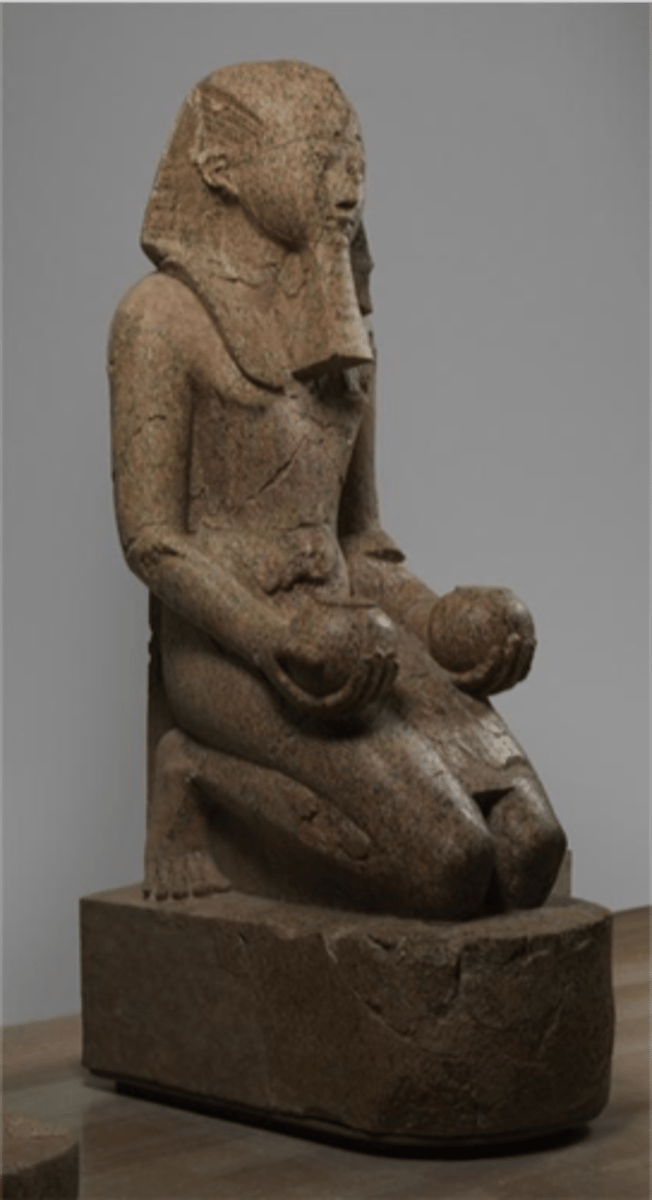
Ziggurat of Ur anc meso
Culture: Sumerian
Location: Ur (now southern Iraq)
Medium: Architecture
Structure: Massive rectangular pyramidal structure with three terraces and staircases
Function: Artificial mountain for worshiping gods in flat Mesopotamian landscape
Dedication: Built by King Ur-Nammu for Nanna/Sîn (moon god)
Historical Context: From Third Dynasty of Ur, last Sumerian-dominated period
The Ziggurat of Ur was used to worship the gods. Worship ceremonies both propitiated the gods and reinforced the divine mandate of the land's rulers. Each Ziggurat was dedicated to a different deity.
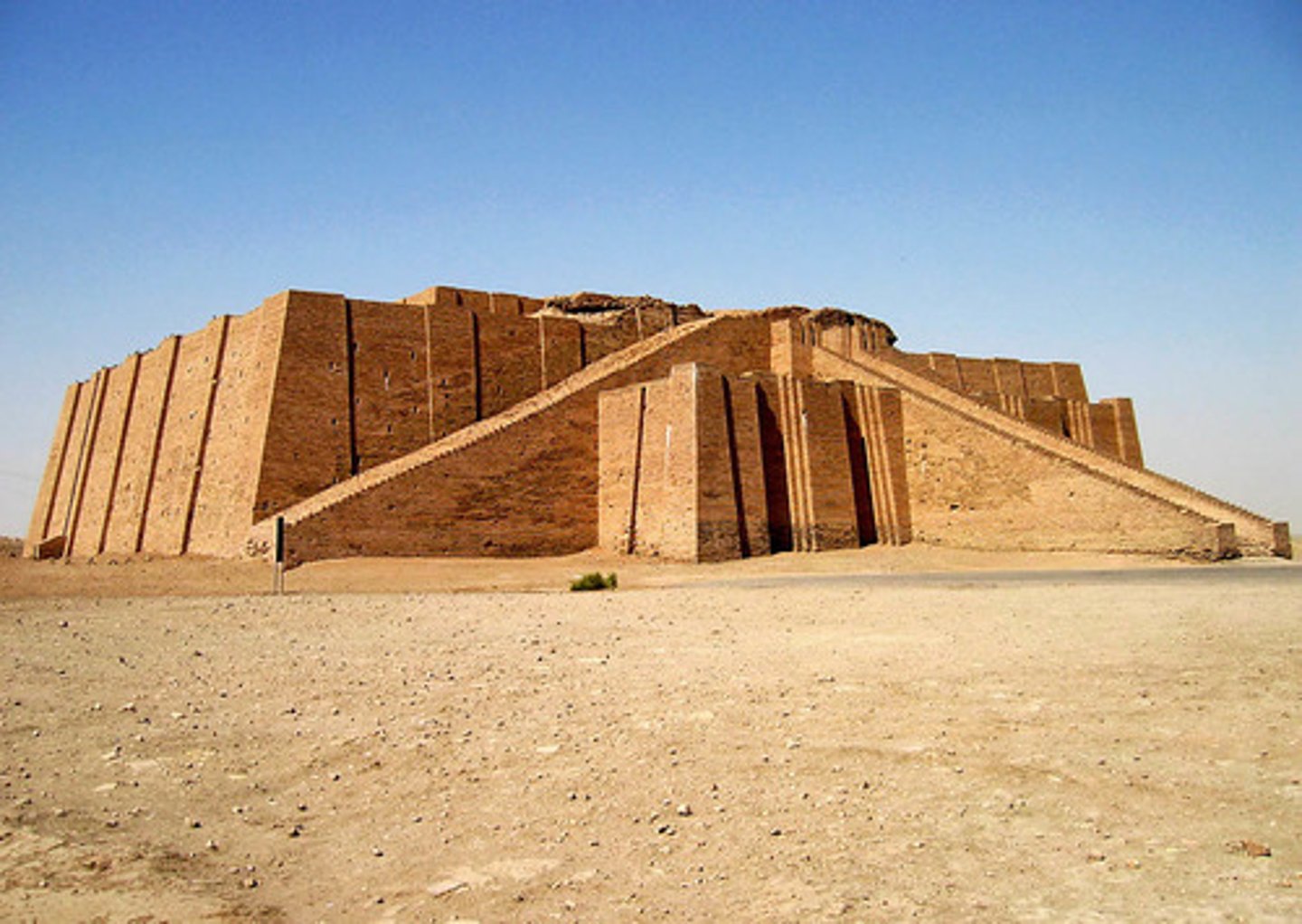
Law Code of Hammurabi anc meso
Culture: Babylonian
Medium: Basalt stele with cuneiform script
Content: Legal codes and punishments inscribed in Akkadian language
Top Relief: Shows King Hammurabi receiving blessing from Shamash (god of justice)
Historical Importance: Example of published law codes in ancient Mesopotamia
Influence: Echoed in later legal traditions including Hebrew Bible
The Law Code of Hammurabi was important because it was one of the earliest and most comprehensive written legal codes, establishing standards for justice and governing a wide range of social aspects.
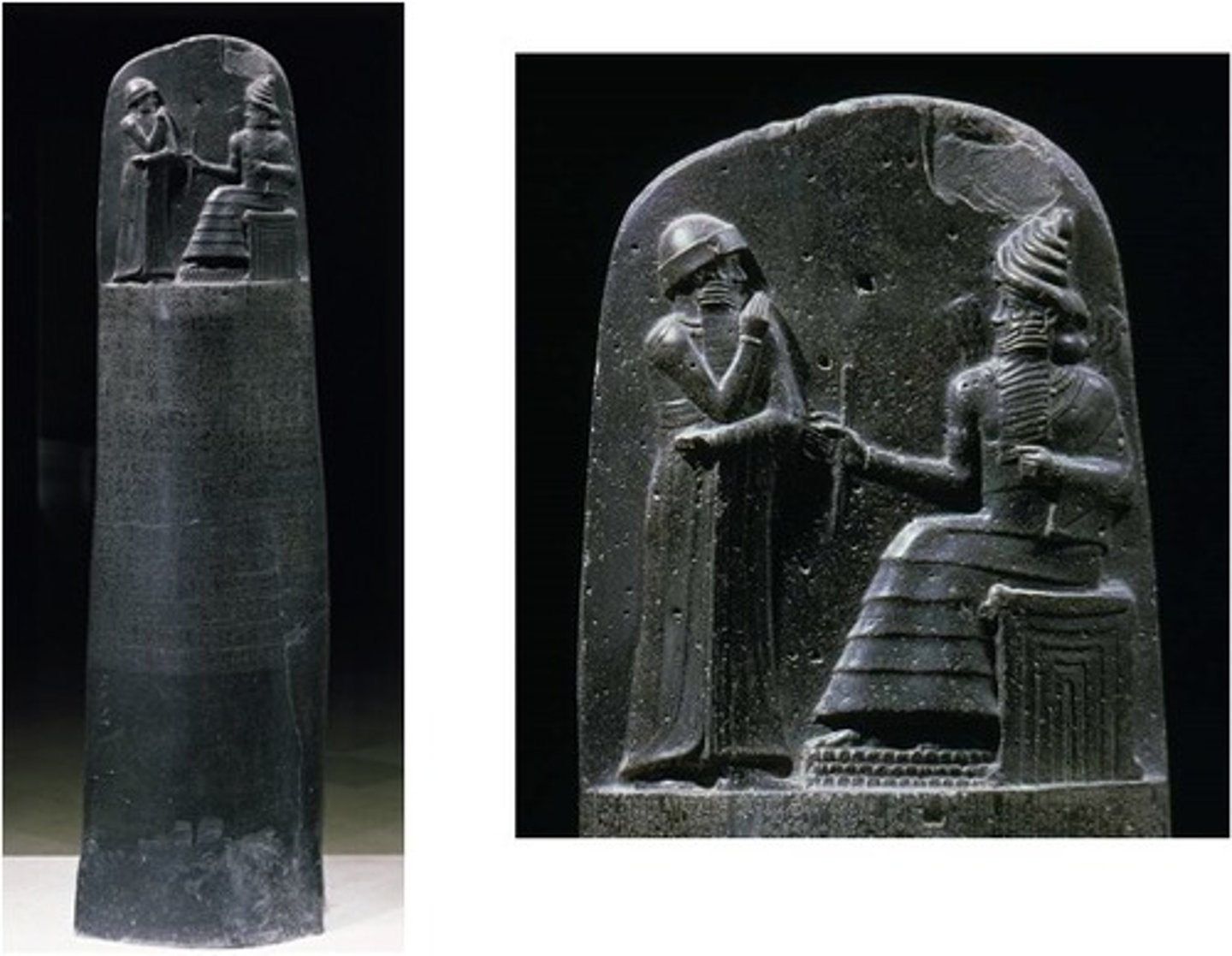
cuneiform tablet - the flood tablet anc meso
Culture: Babylonian
Medium: Clay tablet with Akkadian cuneiform
Content: Part of Epic of Gilgamesh (flood narrative)
Discovery Context: From Library of Ashurbanipal
Historical Significance: When translated in 19th century, caused sensation as antecedent to Noah's flood story
Literary Importance: Shows ancient flood narratives predating Biblical accounts
Cuneiform tablets were important because they were one of the earliest forms of writing, used by ancient mesopotamians to record everything.
The flood tablet is important because its discovery revealed a flood story similar to the one about Noah in the Bible. It also relates with the Epic of Gilgamesh. They were written in cuneiform.
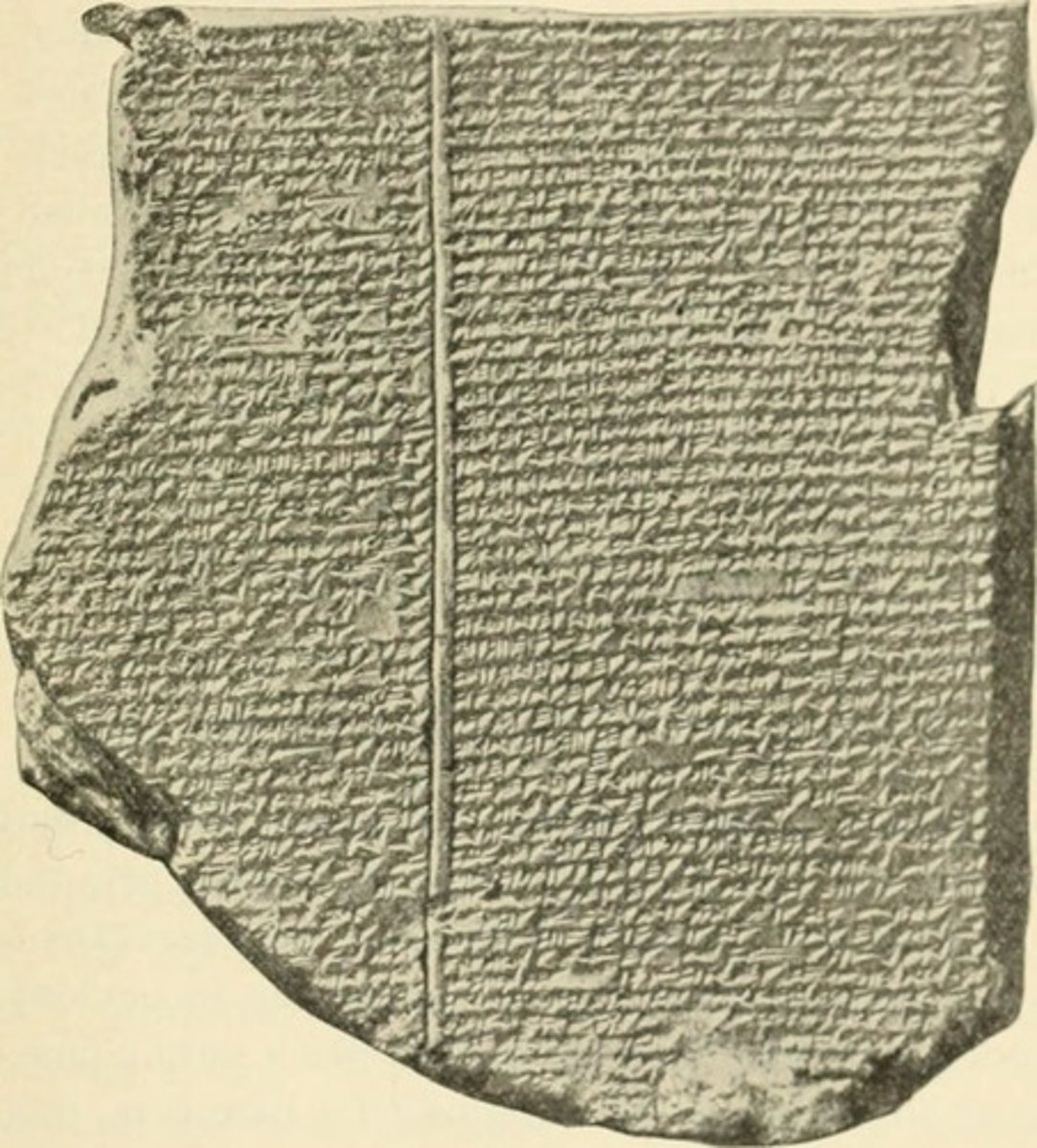
Dura-Europos Archaeological Site
Location: Eastern Syria, on Euphrates River
Historical Rulers: Macedonians → Parthians → Romans → destroyed by Sasanians
Significance: "Crossroad of Cultures" - melting pot of ancient Middle East
Religious Diversity: Contains world's oldest church, early synagogue, Mithraeum, various temples
Preservation: Destruction in 256 CE ironically preserved buildings under rubble
Dura Europos is important because it was a frontier city that served as a crossroads of ancient cultures, and its archaeological preservation provides a unique window into life and religious practices.
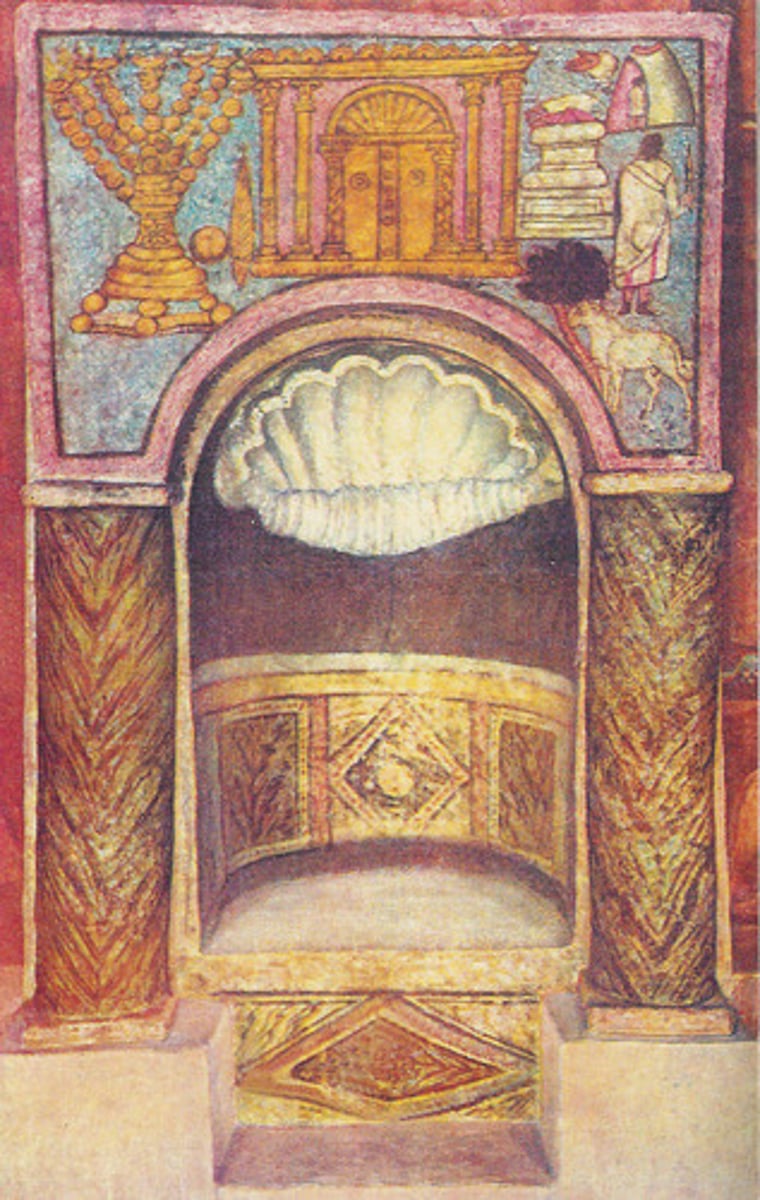
synagogue paintings at dura-europos
Significance: Earliest synagogue found outside Israel
Decoration: Elaborate wall paintings with biblical scenes (Moses, Aaron, Esther)
Color Palette: Greens and yellows, wider range than other religious buildings
Historical Context: Shows Jewish communities integral to Roman urban landscape
The synagogue paintings were important because they provided the earliest surviving example of continuous biblical narrative painting, revealing the vibrant and complex culture of the Jewish community.
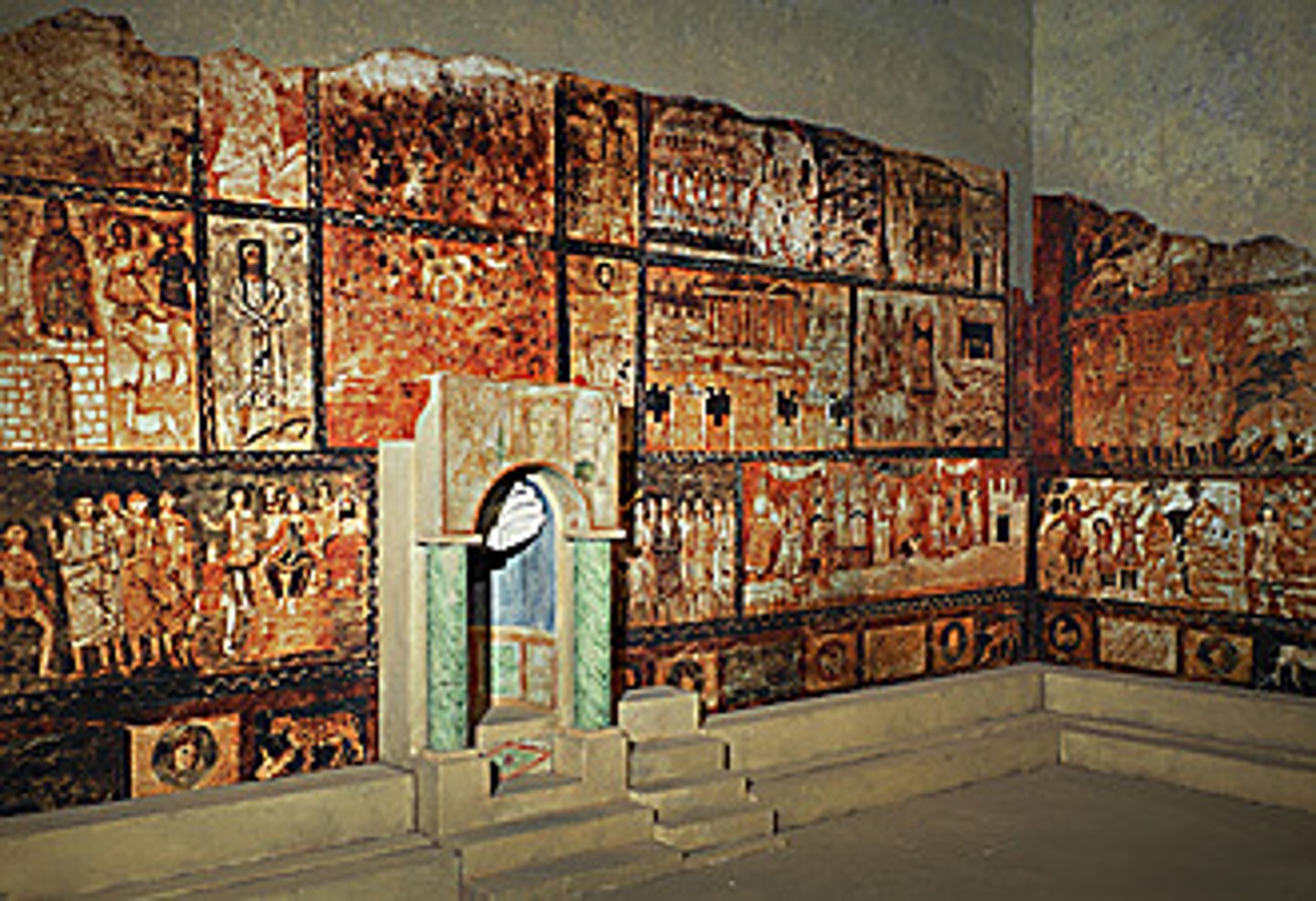
Christian House Church at Dura-Europos
Significance: Contains earliest known baptismal font
Paintings: Biblical scenes in baptistery (Jesus walking on water, Good Shepherd, David and Goliath)
Size: Much smaller than synagogue, suggesting smaller Christian community
Status: Underground religious community, still persecuted at this time
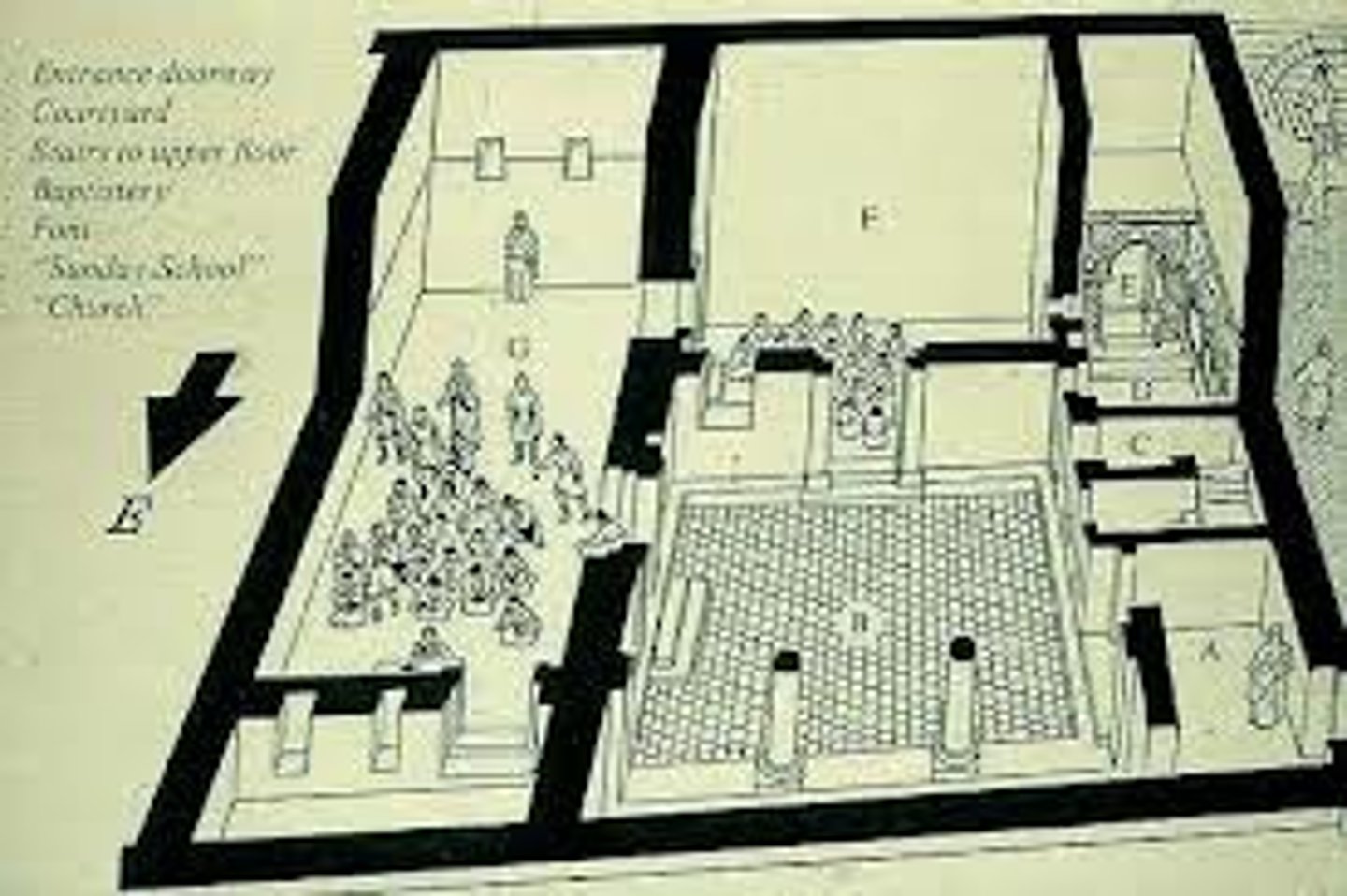
Mithraeum at Dura-Europos
Religion: Mystery cult honoring sun god Mithras
Structure: Typical Mithraeum form - long room with benches, cult niche with reliefs of Mithras killing bull
Connection: Likely brought by Roman military
Artistic Style: Shows Mithras as Palmyrene archer, reflecting local military presence
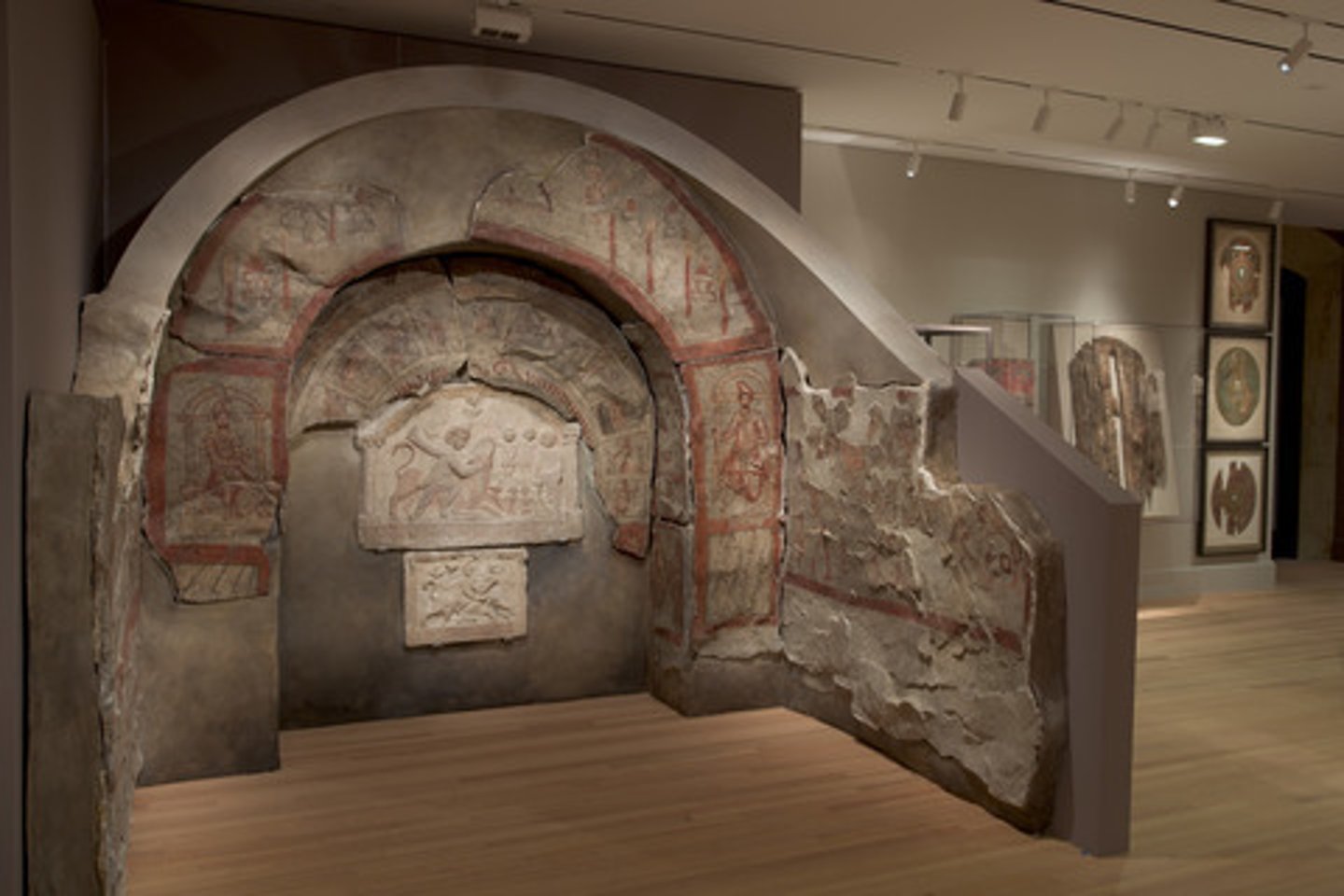
Vishnu Asleep on the Serpent Ananta anc india
Location: Deogarh Temple, India
Religion: Hindu
Medium: High-relief stone carving
Iconography: Four-armed Vishnu reclining, dreaming Universe into existence
Figures: Lakshmi (wife) at feet, Shiva and Brahma above
Style: Gupta period - graceful, elastic body forms (contrast to more muscular Gandhara Buddhist sculpture)
Scale: Hierarchical scale - Vishnu largest figure
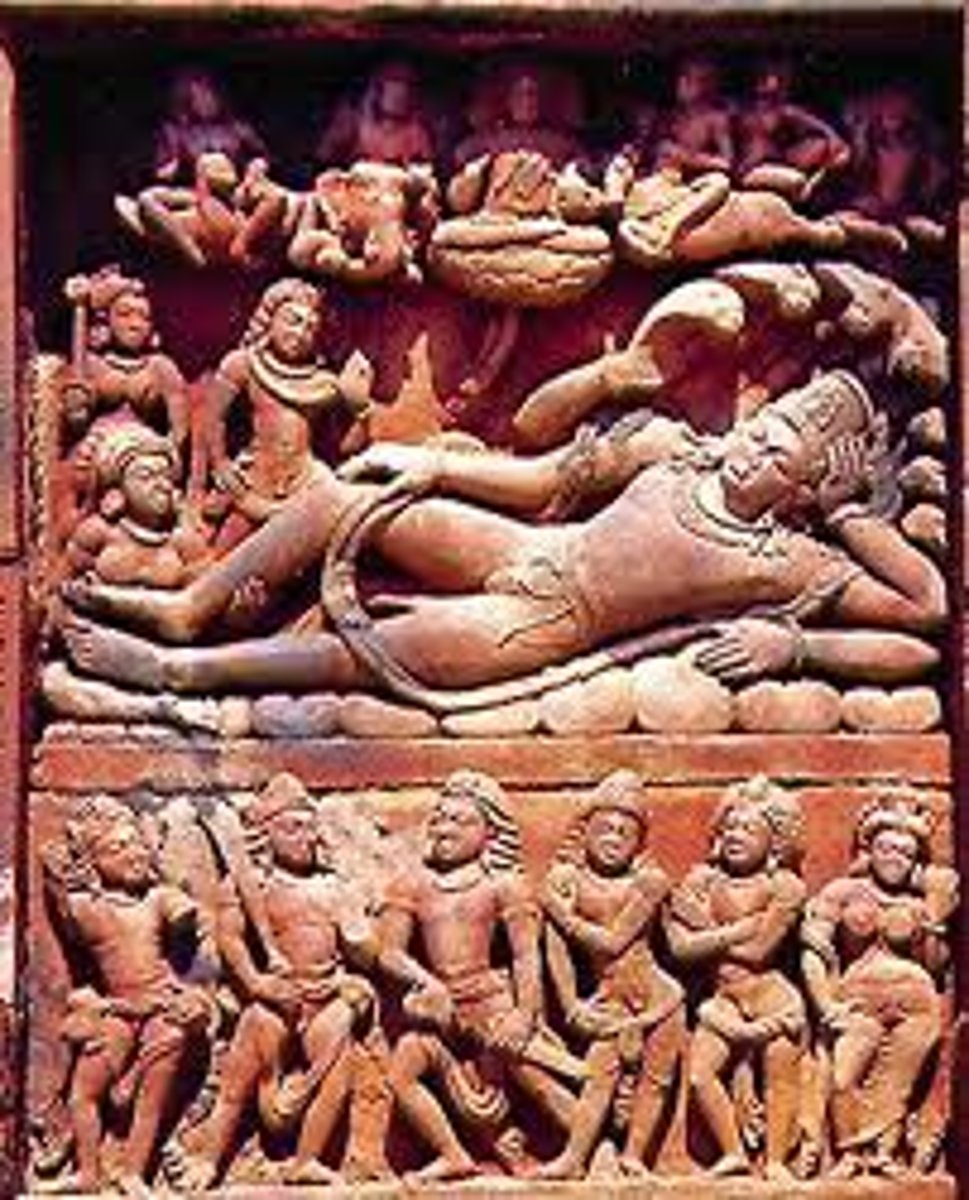
Gandhara Seated Buddha anc india
Culture: Gandhara (eastern Afghanistan/western Pakistan)
Medium: Bronze statuette
Style: Hellenistic influence - shows cross-cultural exchange after Alexander's conquest
Features: Mustachioed Buddha, cross-legged, right hand in welcome gesture (abhaya mudra), sun-burst halo
Historical Context: Gandhara as crossroads of cultures and goods
Artistic Influence: Similar to early Christian art - both traditions influenced by Hellenistic artists
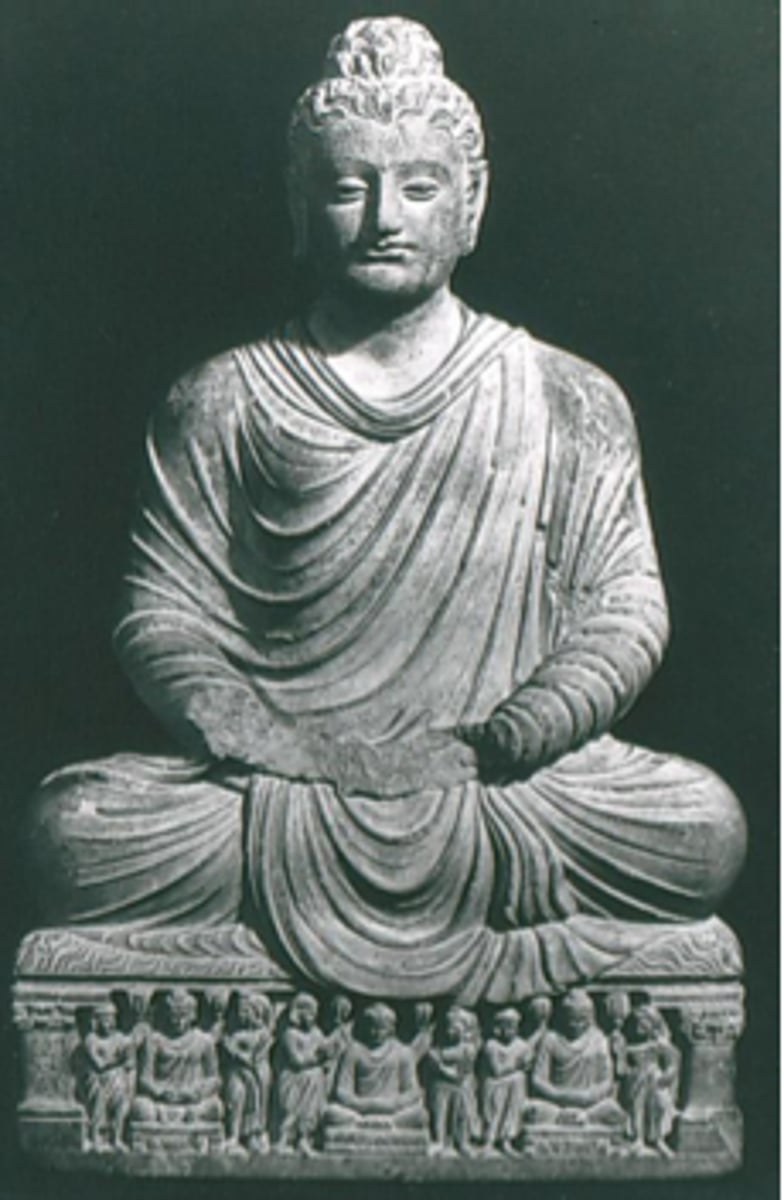
Pillar of Ashoka - Sarnath anc india
Ruler: Mauryan King Ashoka
Medium: Stone capital with four lions seated back-to-back
Historical Context: Ashoka converted from brutal tyrant to Buddhist after repenting violence
Function: Monumental pillars throughout South Asia inscribed with Buddhist edicts
Symbolism: Lions = upholders of dharma; wheel = wheel of dharma (Buddhist law)
Modern Legacy: Wheel on current Indian flag (Ashoka Chakra) based on this sculpture
Inscription: "Schism edict" warning against conflict in Buddhist communities
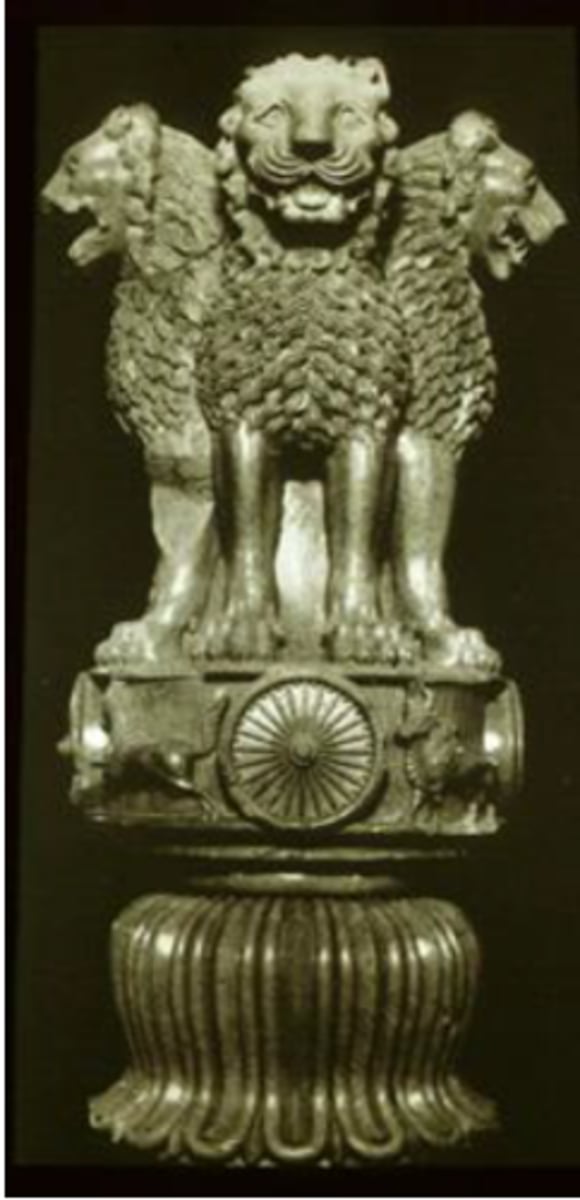
nike of samothrace anc greek
Period: Hellenistic
Medium: Marble sculpture
Subject: Nike (Victory) alighting on ship prow
Style: Hellenistic taste for spectacular - illusion of flight in stone
Condition: Headless and armless
Artistic Achievement: Masterful creation of movement and divine approval in static medium
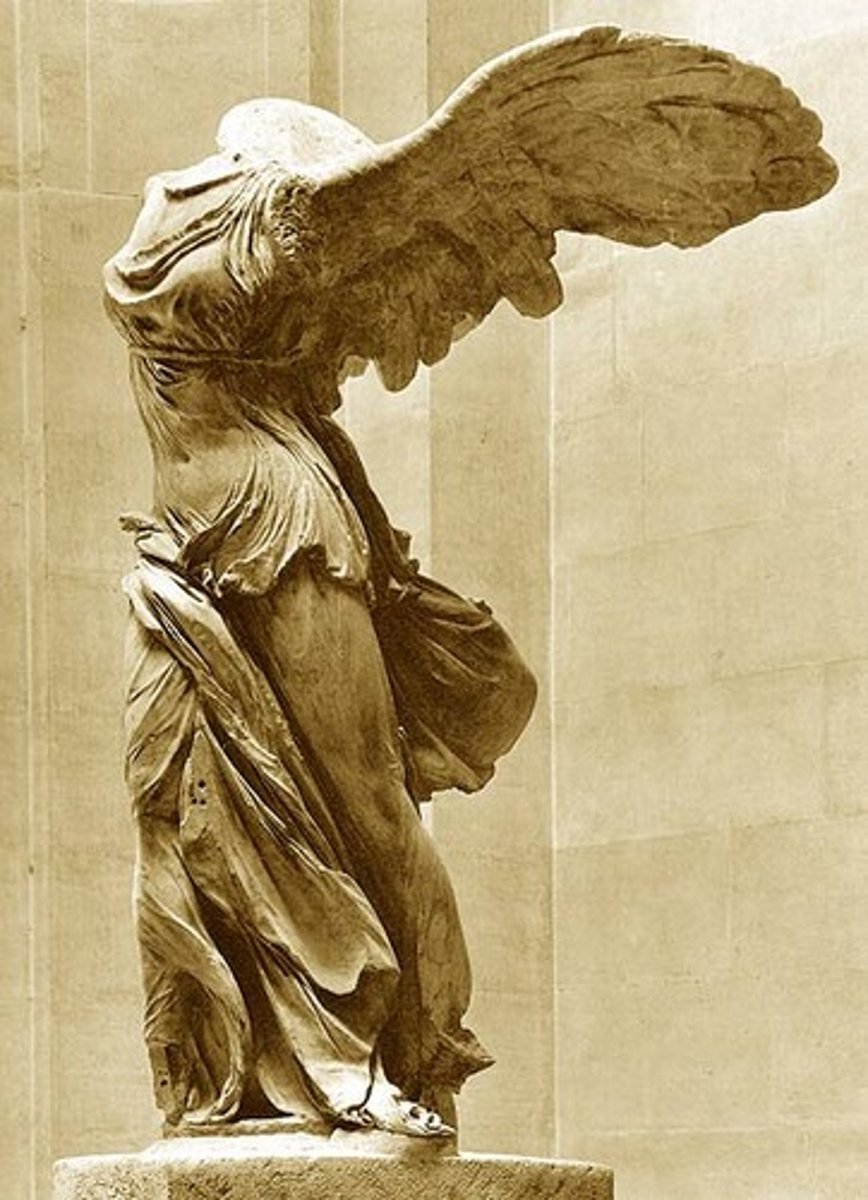
Theater of Delphi anc greek
Period: Classical Greek
Medium: Architecture
Structure: Stone amphitheater with circular stage, 35 rows of stone benches
Location Significance: At Delphi sanctuary, considered "navel of the world" by Greeks
Function: Performances of Greek drama and comedy
Cultural Importance: Shows Greek ritual practices, beliefs, entertainment
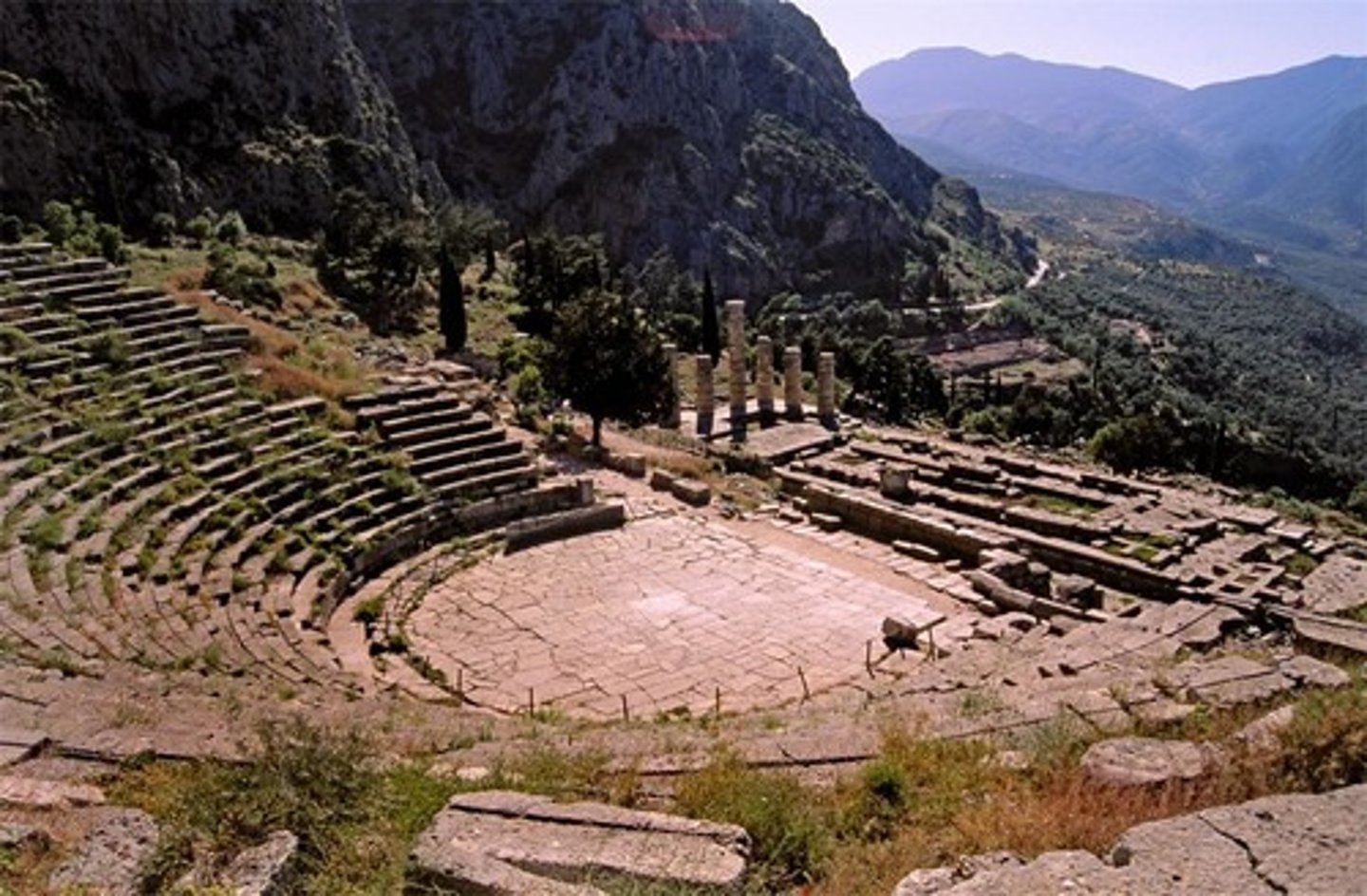
Kouros Youth from Attica anc greek
Period: Archaic Greek
Medium: Life-sized carved marble
Function: Grave marker
Style: Geometric phase - shows Egyptian influence
Features: Male nude, left foot forward, rigid arms, clenched fists
Geometric Elements: Trapezoids at knees, diamond shapes for ribcage and pelvis
Historical Context: Within two generations, Greek sculpture moved toward more dynamic poses
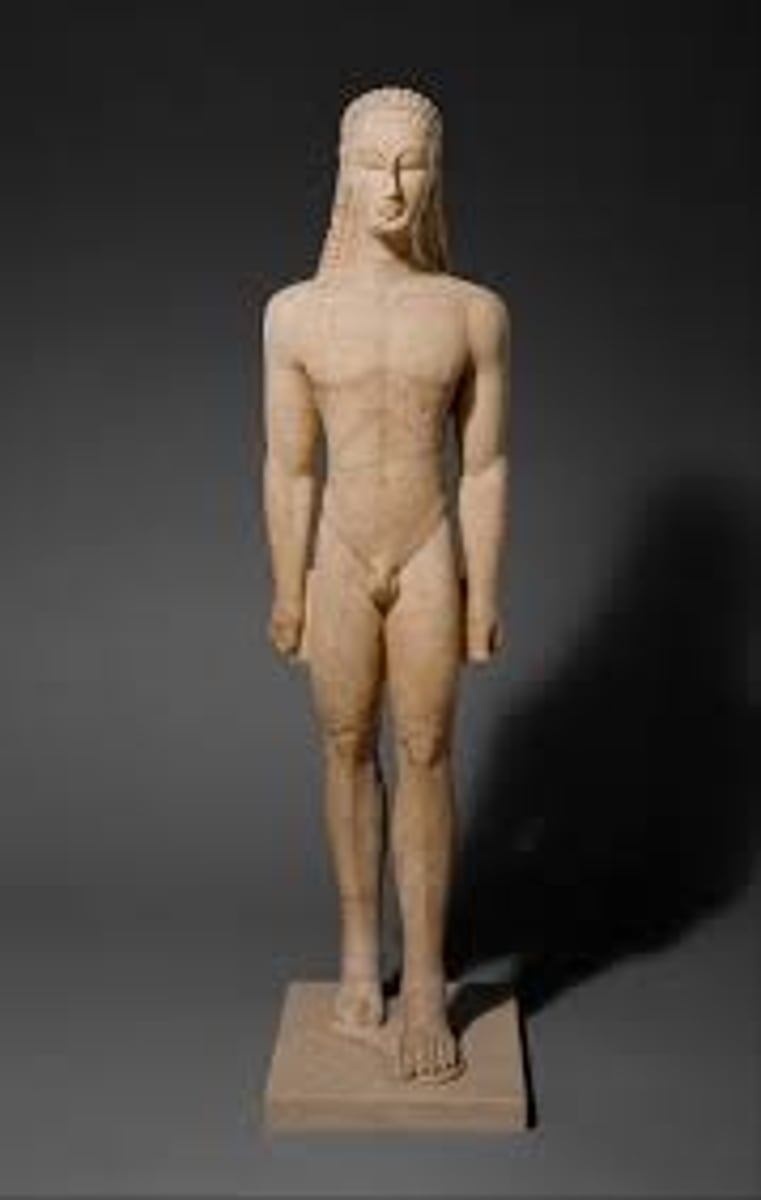
Kritios Boy anc greek
Period: Early Classical (Severe Style)
Medium: Marble sculpture
Innovation: Contrapposto pose - relaxed stance with slight S-curve spine
Transition: Represents shift from Archaic rigidity to Classical naturalism
Features: Weight-bearing hip balanced by opposite shoulder, slight head turn
Facial Expression: Vacant expression, diminished archaic smile
Significance: Exemplifies Early Classical style breakthrough
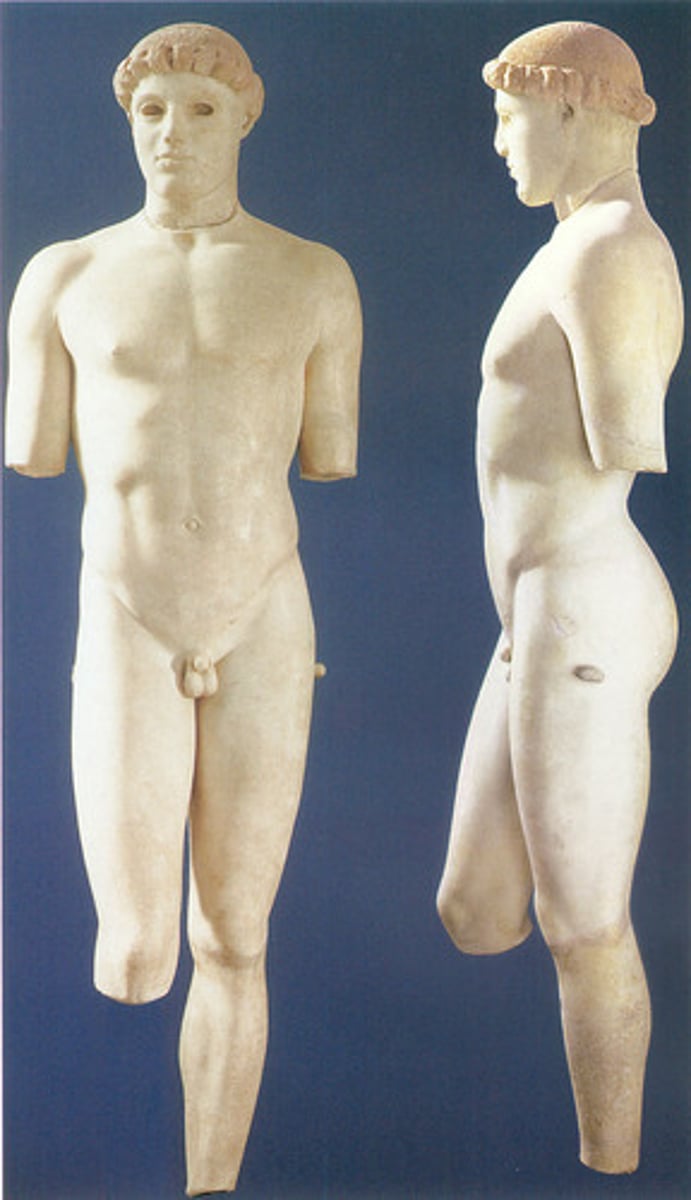
Theater of Dionysus - Acropolis anc greek
Period: Classical Greek
Location: Athens, Greece
Structure: Semi-circular seating built into hillside, U-shaped stone orchestra
Historical Significance: Likely venue for plays by Sophocles, Euripides, other major dramatists
Cultural Importance: Center of Greek theatrical tradition
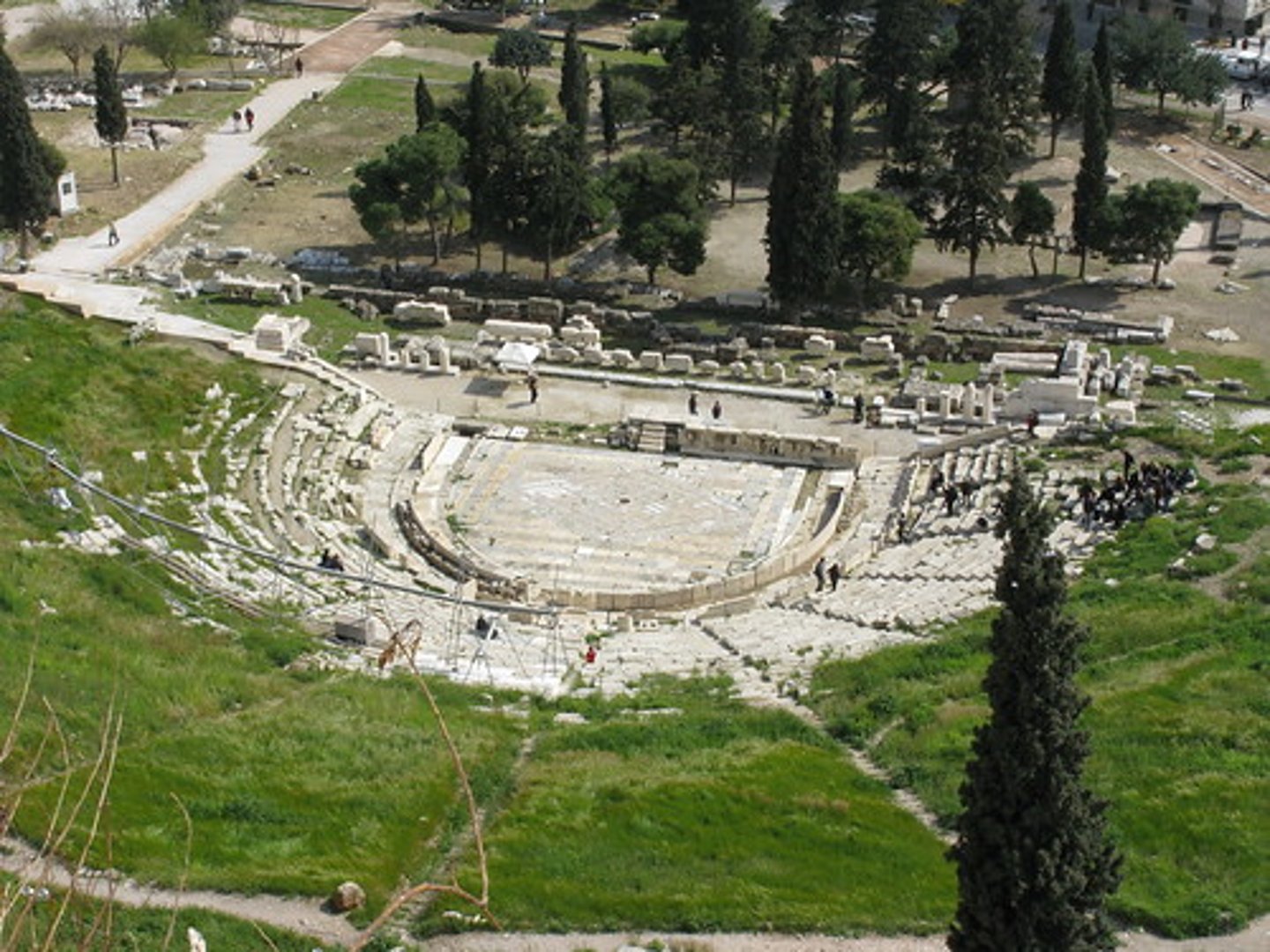
Parthenon, Acropolis
Period: Classical Greek
Architects: Iktinos and Callicrates
Structure: Doric temple - 8 columns on short sides, 17 on long sides
Mathematical Precision: 9:4 ratio applies to almost all building elements
Optical Illusions: Architects created visual corrections to enhance human perception and add dynamism
Significance: Pinnacle of Classical Greek architectural achievement
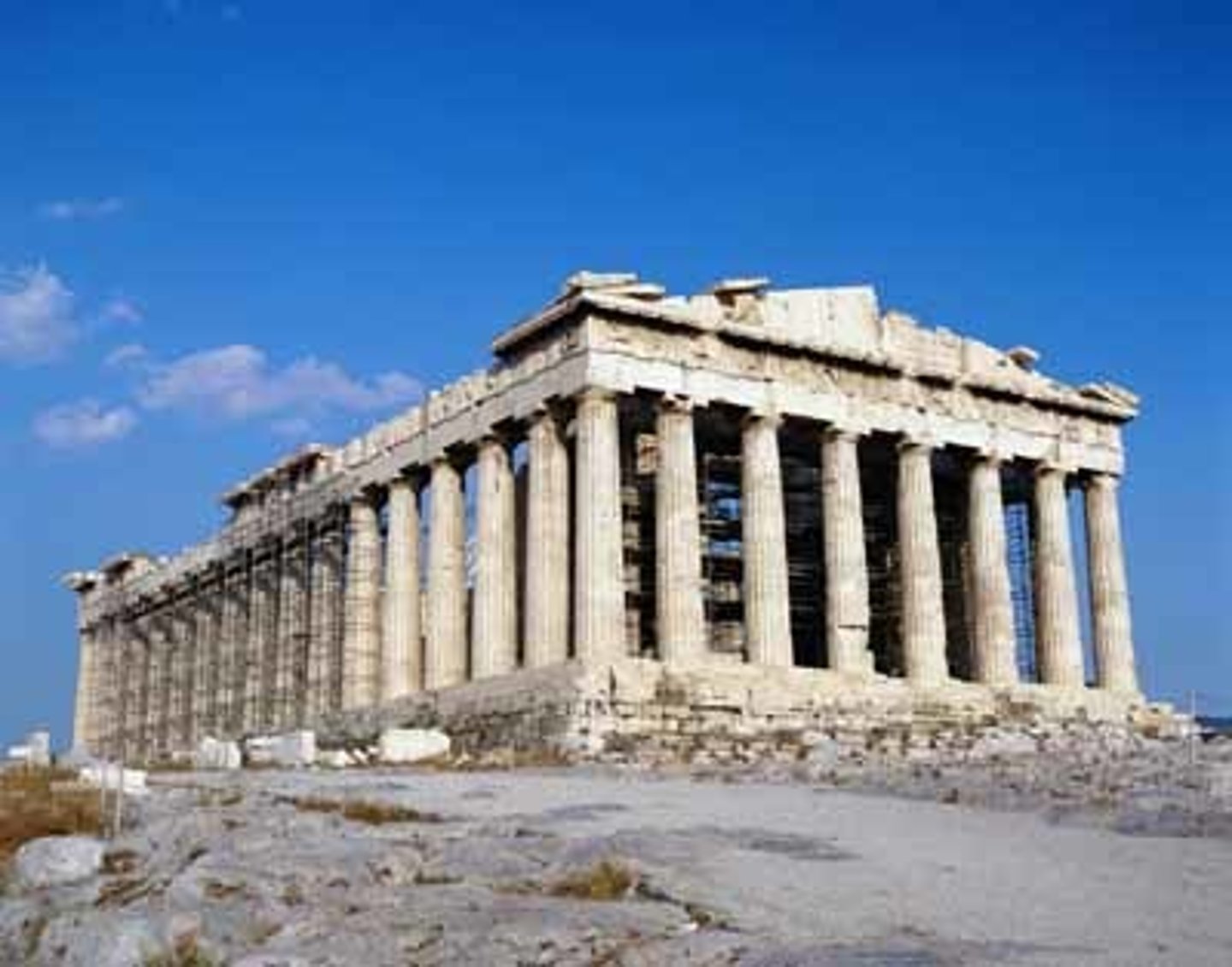
provenance
Provenance: the place of origin or earliest known history of something.